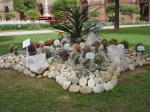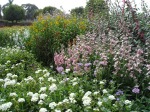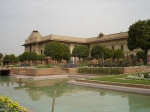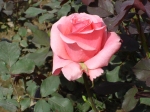World of Saba
Let me show you my world, through my eyes…….
Temples of Chattisgarh…
If Kullu is called the ‘valley of gods’ then Chattisgarh comes a close second. The state formed on1st November 2000 is still in its primary stages of development. Largely a tribal dominant place the state boasts of the richest bio diversity habitat where 40 percent of the state is covered with dense forest and bewildering wild life. Chattisgarh is famous not only for its wildlife but also for its scenic beauty, cool waterfalls, dams, kosa silk. (chattisgarh is the largest producer of kosa silk in the world) and last but not the least its ancient temples. Tourism to the brick temples of ancient times in Chattisgarh is soon gaining momentum and has become one of the major attractions for people who are interested in a pilgrimage or religious tourism. Some of the main temples which are a must visit and historically relevant for all are Rajim, Champaran, Aarang, Sirpur etc.
Rajim temple is situated just 40 kilometers from the capital city of Raipuron the confluence of three holy rivers the Mahanadi, the Pairi and theSondu River. The place has become the second site for the annual Mahakumbh Mela which is held in prayag every three years. There are many groups of temples in the vicinity of one boundary but the main attraction is Rajivalochana temple which is dedicated to lord Vishnu. The others depict the various incarnations of Vishnu such as Vamana(dwarf), Narsimha( human body with a face of lion), Badrinath and Jagnnath. The priest of the temple decorates the idol four times in a day. The first getup of the idol is that of a child then at noon it is changed to that of a young man, in the evening he is dressed up as a old man and then finally as a God. Another prime attraction of the temple is the annual fair called the Rajim Lochan Mahotsav held every year from 16th February to 1st march. The fair is held on a grand scale and people from all over the country participate in the cultural extravaganza.
Around ten kilometers further are the temples of Champaran. Champaran was earlier known as Champajhar and is the birthplace of Saint Vallabhacharya. Vallabhacharya was the reformer and founder of Vallabh sect and therefore is of great religious significance. The place has a temple constructed in his honour and his followers come from all over the country and abroad to pay their homage during the month of Magh (January –February) when a big annual fest is held to celebrate the birth anniversary of the saint.
Aarang is again another few kilometers from Champaran. All three temples (Rajim, Champaran and Aarang) can be visited in one day as they are in close proximity and only a couple of miles away from each other. This temple is said to be built in the 6th or 7th century. The most fascinating fact about this temple is that the bricks used are one single slab without any modification or cuts. One of the main ancient idols was stolen from this very temple last year and then recovered by the Chattisgarh police. The news created waves in the country.
This slideshow requires JavaScript.
Lucknow…
Ye Lucknow ki sar zamin
Ye rang-o-roop ka chaman
Ye husn-o-ishq ka vatan
Yahi to vo muqaam hai
jahan awadh ki sham hai
shabab-o-shair ka ye ghar
Ye ahl-e-ilm ka nagar
Hai manzilon ki god mein
Yahaan har ek rah guzar
Ye shahar lalazaar hai
Yahaan dilon mein pyaar hai
Formerly known as Awadh – Lucknow is a hallmark of cultural extravaganza. It is a city well known for its splendours. When you walk through the lanes and by lanes of Chowk or Aminabad you can still find the Awadhi ‘tehzib’ or mannerisms prominent in the speech of common people. It is a city which still speaks the language of “aap- janab” and the dictum is a part of everyday life of a true Lucknawi.
Though the dress forms have changed considerably in the span of last fifty years yet the beauty and charisma of Chikankari- the delicate hand embroidery still rules the wardrobe of most of the people. Chikankari is renowned for its timeless grace and gossamer delicacy, a skill which is more than 200 years old.
Chikankari is said to be introduced in India, by Noorjehan the Persian wife of the Mughal Emperor Jehangir. The word Chikan in Persian means drapery; however, some people insist that the art of Chikankari originally belongs to Bengal and was introduced in Lucknow when the Mughal dynasty was losing power in the state and gaining momentum in Lucknow. It is said that most artisans who were expert at the art, moved to Awadh in search of employment. The art found a place in the British homes and thus resulted in export of Chikankari articles. From table cloths, curtains, apparel everything was being consumed by the British. Till date it is one art form which is world famous and in demand round the year.
The city offers a wide range of exotic eateries and outlandish tourism extravaganza including the famous ‘tunde kebabs’ and ‘kulcha nihari’.
The places one just cannot miss upon are Bada Imamabara, Hazaratganj and Aminabad markets. Bada Imamabara is a famous tourist spot built by the Nawab of Awadh, Asaf -ud-Daula whereas the Chota Imamabara was built later by Mohamad Ali Shah.
The Bada Imamabara, apart from the Asfi mosque is also famous for Bhul Bhulayya (the Labrynth) and a summer palace with running water. Both the places were built in order to provide employment to the locals, who were suffering from the ongoing famine year after year. Another intriguing structure at the Bada Imambara is the five-storied baoli (step well), which belongs to the pre-Nawabi era. It is called the Shahi-Hammam (royal bath), this baoli is connected with the river Gomti and only the first two stories are above water, the rest being under water.
This slideshow requires JavaScript.
Mughal Gardens…
This slideshow requires JavaScript.
Mughal Gardens are a very popular tourist spot in Delhi during the months of February and March. This is the only time the garden situated in the complex of the Rashtrapati Bhavan, the official residence of the president of India, is in its full bloom and open to the public.The garden was initially designed for Lady Harding by Sir Edward Lutyen and occupies an area of 15 acres. It is divided into three sections rectangular, long and circular gardens. All the gardens have layered beds of flowers and the sight is undoubtedly a feast for the eyes. It is an amalgamation of Mughal and British style with fine waterways dividing the green beds of grass finely into paths and causeways. The stylized fountains and terraces are margined with green hedges and flowers. The circular garden is perhaps the best landscape one could ever wish to see, with a rotating fountain in the center sprinkling water in all directions. The stepwise flowerbeds of different colours around the pond present a feast for the butterflies. On the sides it has separate beds of roses with small trimmed hedge of Ingadulets (small white grass flowers), giving effect of the coloured knots on a vast carpet. The circular garden is also known as the pearl garden or the butterfly garden.
The long garden as it is called, is a path leading to the circular garden. On both the sides of the path are 16 shaped beds of roses surrounded by a low hedge and red sandstone pillars. The pillars are covered with the rose creepers and small baskets of tulips and pansies hang from a rope tied between the pillars. One can find almost all the varieties of roses in all vibrant colours one can even think of. The sweet aroma of roses is simply intoxicating. The caretakers of the garden have often seen peacocks dancing and taking a leisurely walk among the roses. Needless to say the sight is very romantic and the experience- once in a lifetime!
The garden is visited by thousands of people every year and leaves them spellbound. This year the visually impaired can also go and enjoy the aroma of different plants. A special garden named Tactile has been especially designed for them. Another major attraction for the general public is the musical fountain, which plays patriotic songs.
The Mughal Garden also has a small place devoted to the animal kingdom; the corner mostly loved by young kids and has deer, swans ducks and different other birds.
The garden is open on all days except Monday from 10.30 a.m. to 4.00 p.m. for public. Electronic gadgets like mobile phones and camera are not allowed inside the garden, the fact mostly comes as a big disappointment for the visitors but then one has to pay a price to take a walk in the paradise.
Humayun’s Tomb…
The Taj Mahal in Agra is famous worldwide as a tribute to love; love of the Mughal emperor Shahjahan for his beloved wife Mumtaz. The monument has an exceptional architecture and it stands upright in its purest form all in white marble specially imported from Iran. However, less people know that the inspiration behind the Taj Mahal is Humayun’s Tomb. The tomb was built by his wife Haji Begum in memory of Humayun, the second Mughal Emperor who ruled India for almost a decade. The Humayun’s Tomb clearly exhibits the influence of Persian art as his wife and the architect Mirak Mirza Ghayas both were from Persia. The site chosen to build the tomb was on the banks of Yamuna River just opposite the shrine of the Sufi saint of Chishtiya Silsila, Hazrat Nizamuddin Aulia.

Hello world!
Welcome to WordPress.com! This is your very first post. Click the Edit link to modify or delete it, or start a new post. If you like, use this post to tell readers why you started this blog and what you plan to do with it.
Happy blogging!
-
Recent Posts
Archives
Categories
Meta



























































